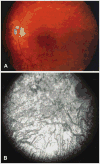Vision loss in juvenile neuronal ceroid lipofuscinosis (CLN3 disease)
- PMID: 26748992
- PMCID: PMC5025599
- DOI: 10.1111/nyas.12990
Vision loss in juvenile neuronal ceroid lipofuscinosis (CLN3 disease)
Abstract
Juvenile neuronal ceroid lipofuscinosis (JNCL; also known as CLN3 disease) is a devastating neurodegenerative lysosomal storage disorder and the most common form of Batten disease. Progressive visual and neurological symptoms lead to mortality in patients by the third decade. Although ceroid-lipofuscinosis, neuronal 3 (CLN3) has been identified as the sole disease gene, the biochemical and cellular bases of JNCL and the functions of CLN3 are yet to be fully understood. As severe ocular pathologies manifest early in disease progression, the retina is an ideal tissue to study in the efforts to unravel disease etiology and design therapeutics. There are significant discrepancies in the ocular phenotypes between human JNCL and existing murine models, impeding investigations on the sequence of events occurring during the progression of vision impairment. This review focuses on current understanding of vision loss in JNCL and discusses future research directions toward molecular dissection of the pathogenesis of the disease and associated vision problems in order to ultimately improve the quality of patient life and cure the disease.
Keywords: CLN3; juvenile neuronal ceroid lipofuscinosis; ocular pathologies; retina; vision loss.
© 2016 New York Academy of Sciences.
Conflict of interest statement
The authors declare no conflicts of interest.
Figures




Similar articles
-
Loss of CLN3, the gene mutated in juvenile neuronal ceroid lipofuscinosis, leads to metabolic impairment and autophagy induction in retinal pigment epithelium.Biochim Biophys Acta Mol Basis Dis. 2020 Oct 1;1866(10):165883. doi: 10.1016/j.bbadis.2020.165883. Epub 2020 Jun 25. Biochim Biophys Acta Mol Basis Dis. 2020. PMID: 32592935 Free PMC article.
-
Self-Complementary AAV9 Gene Delivery Partially Corrects Pathology Associated with Juvenile Neuronal Ceroid Lipofuscinosis (CLN3).J Neurosci. 2016 Sep 14;36(37):9669-82. doi: 10.1523/JNEUROSCI.1635-16.2016. J Neurosci. 2016. PMID: 27629717 Free PMC article.
-
Current Insights in Elucidation of Possible Molecular Mechanisms of the Juvenile Form of Batten Disease.Int J Mol Sci. 2020 Oct 29;21(21):8055. doi: 10.3390/ijms21218055. Int J Mol Sci. 2020. PMID: 33137890 Free PMC article. Review.
-
Deletion of the Caenorhabditis elegans homologues of the CLN3 gene, involved in human juvenile neuronal ceroid lipofuscinosis, causes a mild progeric phenotype.J Inherit Metab Dis. 2005;28(6):1065-80. doi: 10.1007/s10545-005-0125-7. J Inherit Metab Dis. 2005. PMID: 16435200
-
Juvenile neuronal ceroid-lipofuscinosis (Batten disease): a brief review and update.Curr Mol Med. 2007 Sep;7(6):603-8. doi: 10.2174/156652407781695729. Curr Mol Med. 2007. PMID: 17896996 Review.
Cited by
-
Paroxysmal sympathetic hyperactivity following status epilepticus in a 22-year-old with Juvenile Neuronal Ceroid Lipofuscinosis: A case report.Epilepsy Behav Rep. 2021 Jan 19;15:100427. doi: 10.1016/j.ebr.2021.100427. eCollection 2021. Epilepsy Behav Rep. 2021. PMID: 33681754 Free PMC article.
-
Loss of CLN3, the gene mutated in juvenile neuronal ceroid lipofuscinosis, leads to metabolic impairment and autophagy induction in retinal pigment epithelium.Biochim Biophys Acta Mol Basis Dis. 2020 Oct 1;1866(10):165883. doi: 10.1016/j.bbadis.2020.165883. Epub 2020 Jun 25. Biochim Biophys Acta Mol Basis Dis. 2020. PMID: 32592935 Free PMC article.
-
Genetic and Cellular Basis of Impaired Phagocytosis and Photoreceptor Degeneration in CLN3 Disease.Invest Ophthalmol Vis Sci. 2024 Nov 4;65(13):23. doi: 10.1167/iovs.65.13.23. Invest Ophthalmol Vis Sci. 2024. PMID: 39535788 Free PMC article.
-
Clinical and biochemical footprints of inherited metabolic disorders. VII. Ocular phenotypes.Mol Genet Metab. 2022 Apr;135(4):311-319. doi: 10.1016/j.ymgme.2022.02.002. Epub 2022 Feb 15. Mol Genet Metab. 2022. PMID: 35227579 Free PMC article. Review.
-
Synapse alterations precede neuronal damage and storage pathology in a human cerebral organoid model of CLN3-juvenile neuronal ceroid lipofuscinosis.Acta Neuropathol Commun. 2019 Dec 30;7(1):222. doi: 10.1186/s40478-019-0871-7. Acta Neuropathol Commun. 2019. PMID: 31888773 Free PMC article.
References
-
- Pérez-Poyato MS, et al. Juvenile neuronal ceroid lipofuscinosis: clinical course and genetic studies in Spanish patients. J Inherit Metab Dis. 2011;34:1083–1093. - PubMed
-
- Nielsen AK, Ostergaard JR. Do females with juvenile ceroid lipofuscinosis (Batten disease) have a more severe disease course? The Danish experience. Eur J Paediatr Neurol. 2013;17:265–268. - PubMed
-
- Batten FE. Cerebral degeneration with symmetrical changes in the maculae in two members of a family. Trans Opthalmol Soc UK. 1903;23:386–390.
-
- Williams RE, Mole SE. New nomenclature and classification scheme for the neuronal ceroid lipofuscinoses. Neurology. 2012;79:183–191. - PubMed
Publication types
MeSH terms
Grants and funding
LinkOut - more resources
Full Text Sources
Other Literature Sources
Research Materials

